

The big book of drivers who wheeled Roland Leong’s Hawaiian entries
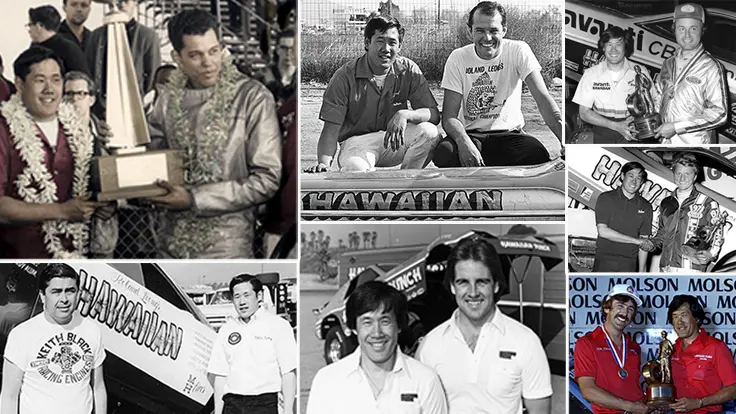

As you've read from me the last couple of weeks, and from tributes I've posted from some of the stars of our sport, there's no way to over-report on the importance of Roland Leong in the history of drag racing. Other than being the guy with whom the legendary "Snake," Don Prudhomme, scored his first career win, Leong is best remembered as a guy who kept drag racing's unemployment list short by hiring a litany of drivers, many of whom are on the Who's Who of the sport.
I wrote the article below for NHRA National Dragster several years ago, and it is worth reprinting as what I think is the most encyclopedic look at the roster of Leong's drivers as well as some great comments from Leong about the difficulties of life on the road and managing personalities under demanding deadlines and situations.
Hello, Goodbye
Legendary car owner Roland Leong has put more than
20 drivers in the seat of his Hawaiian; most didn’t last
by Phil Burgess, reprinted from the March 20, 2009 issue of National Dragster
“Drivers are like spark plugs: If one’s too hot, you just replace him with a cooler one.”
“Drivers are like spark plugs: You burn one out, you screw in another one.”
Roland Leong had heard all the jokes and been the butt of many of them over the decades after hiring, firing, replacing, or losing more than 20 drivers in a 30-year career as one of the sport’s most successful car owners, but he has carved a unique niche in drag racing history.
Unlike renowned car owners of modern times, like Don Schumacher or Don Prudhomme, Leong didn’t first cement his place in the drag racing annals by driving a race car — not that he didn’t try — but by consistently putting on a good enough show to earn bookings whenever and wherever he wanted them, which attracted quality drivers like honey draws flies.
The Hawaii-born road warrior makes no apologies nor has any regrets about the way he conducted business while touring the nation for decades and delighting race fans from coast to coast while making his line of Hawaiian race cars some of the more successful and popular in drag racing history.
“To be honest, there were some personality conflicts, plus you have to remember we were all pretty young and made decisions on emotions instead of common sense,” said Leong, who at 17 years old hired his first driver, fellow countryman and drag racer turned legendary IndyCar racer Danny Ongais.
A procession of drivers followed Ongais into the saddle of the Hawaiian, among them Prudhomme, as well as an assortment of some of the top flopper drivers of the era. As a group, they won Leong more than a dozen NHRA Wallys — including three U.S. Nationals titles — despite running only a limited national event calendar while they earned their bread and butter sometimes far from the national event spotlight in places like Rockford, Ill., and Gary, Ind.
After 30 years of fielding his own cars and another decade tuning for car owners, Leong learned to become part shrink, part peacekeeper, and part babysitter.
“Most of the time, it was me getting rid of them than anything else — different ones, different things,” he said, deferring from citing specific cases. “Some of the guys had cars of their own before me and their ideas on how they thought the car should be run.
“Everyone doesn’t have to get along or go to dinner, but I know that if people on the team like each other, they’re more likely to cover each other. Team chemistry can make a big difference. Look at how all of the guys from Tony Schumacher’s team left with Alan Johnson to go to his new deal. You think they would have done that if they didn’t like each other and have something pretty special? If you have that cohesiveness, it helps you get through the bad times easier.
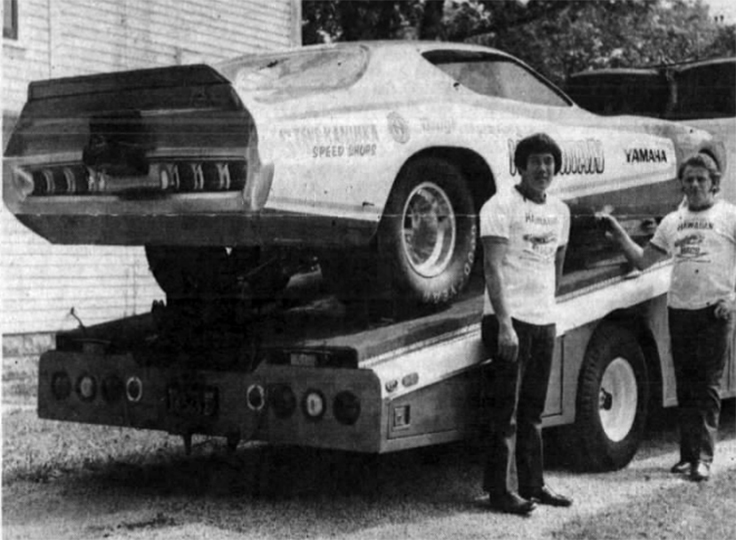
“I like to say that if you haven’t struggled in doing this, you haven’t been doing it long enough, but when you’re going through hard times, things get difficult, especially when you’re on the road, running all over the country like we used to do,” he acknowledged, “and it’s easy to have a clash of personalities and work ethics. I wonder how many of these crew guys and drivers today would be able to make it back then. It’s a whole different kind of travel and work than they do today. Back then, we’d race Tuesdays, Wednesdays, Fridays, Saturdays, and Sundays, and sometimes that was five different tracks. You’ve got different personalities crammed into the crewcab or one hotel room under all the stress and pressure. You really had to have a passion for it; you couldn’t just do it because it was your job.”
It’s safe to say that no personality in drag racing has made more of a lasting name for himself with fans without doing it behind the wheel than Leong, and he’s comfortable with that legacy.
“I have no regrets; if I had to do it all over again, I don’t know that I’d change much,” he said. “C.J. Hart was the track manager at Riverside Raceway when I got my gas dragster license, and he also was the track manager at Long Beach when I crashed, and he took away my license. A year or two before he died, I told him, ‘I need to thank you. If you didn’t take my license away, I probably would have killed myself by now.’ ”
“Looking back on it all, I’ve had some of the worst teams and drivers and some of the best ones, but it was all my doing. I hired and fired them, but I’ll tell you what, it’s easier to make the car run good than to put together a good team.”
Here's the chronological list of Hawaiian drivers, how they came into the ride and how they exited:
DANNY ONGAIS

Hello: Leong had been running a Dragmaster-built Top Gas dragster for two years and even drove the car on occasion, including in Indy in 1963. Leong’s mother, Teddy, who was well-known in the islands as part of a speed-shop operation, dispatched fellow Hawaiian Danny Ongais to help her son in Indy that year. Leong put Ongais behind the wheel of a new car for 1964, during which he won Top Gas at the Winternationals and Hot Rod Championships.
Goodbye: Leong wanted to run Top Fuel, and Ongais originally was going to drive, but the two had “a falling out,” according to Leong.
DON PRUDHOMME
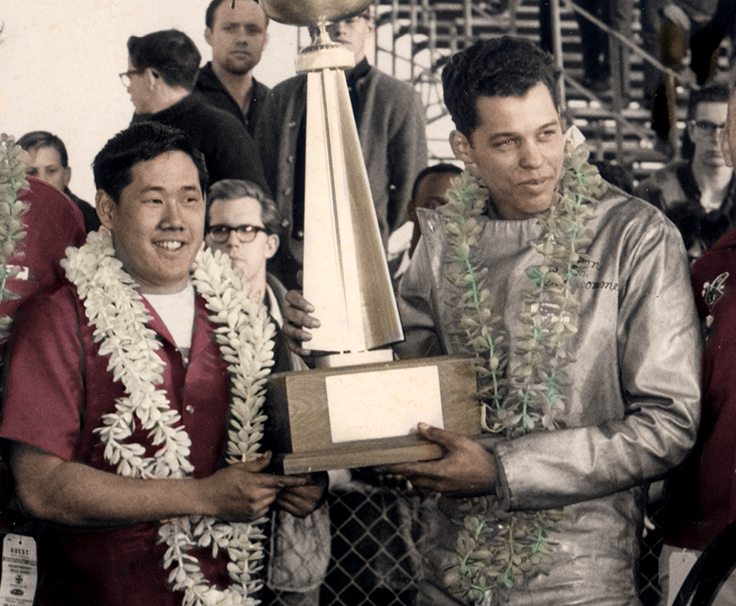
Hello: Leong made an ill-fated attempt to earn his Top Fuel license in mid-1964, but he crashed on his maiden voyage at Lions Drag Strip. Engine maestro Keith Black told Leong he was afraid for him and that he wouldn’t tune for him anymore as long as Leong was driving. The Greer-Black-Prudhomme team had just disbanded, and, at Black’s suggestion, Leong hired Prudhomme. Together they won Top Fuel at the 1965 Winternationals and U.S. Nationals.
Goodbye: Prudhomme was offered a chance to run his own team with the B&M Torkmaster operation in 1966.
MIKE SNIVELY

Hello: Mike Snively had met Leong at the Dragmaster shop a few years earlier and was offered the ride after Prudhomme quit. In 1966, the duo duplicated the Hawaiian’s 1965 feat of winning in both Indy and Pomona and also won the 1967 Hot Rod Championships.
Goodbye: Although Snively later drove Funny Cars, he opted not to take the job driving Leong’s new Funny Car in 1969.
MIKE SOROKIN
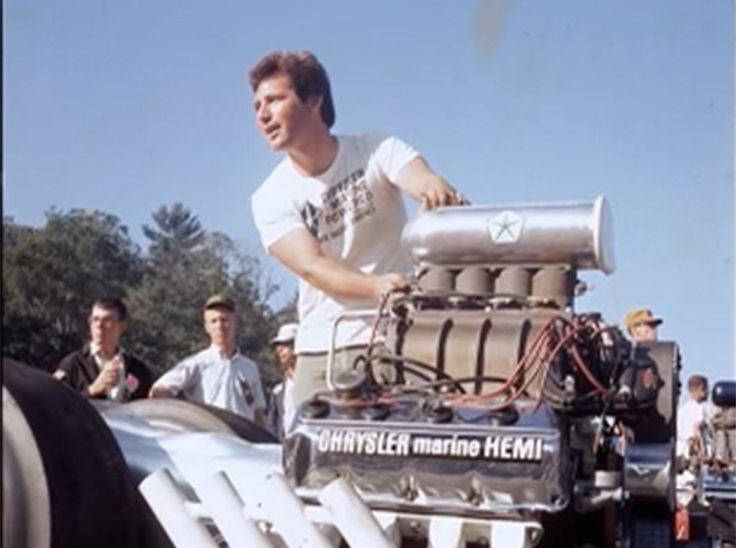
Hello: When Black scored a deal in 1967 with Chrysler Marine to develop the new 426 Hemi engine, Leong hired Mike Sorokin, former pilot of the popular Surfers dragster, to run a second Hawaiian dragster (painted red) on the West Coast with the late-model powerplant while Leong and Snively toured with their conventional blue, 392-powered entry.
Goodbye: The late-model engine finally went into the No. 1 car, and Leong, weary of running two cars, parked the second one and prepared for the move to Funny Car. Sorokin moved to Tony Waters’ car, in which he later lost his life.
LARRY REYES

Hello: Larry Reyes, already an experienced Funny Car pilot, was between rides when he met Leong at Black’s shop in South Gate, Calif., where Leong, at the advice of Gene Snow, offered Reyes the job as his first flopper pilot. They made a spectacular debut in Leong’s first car, an ill-handling, full-sized Charger that Reyes hated from the beginning and hated even more after it flew at the finish line in Pomona, destroying the car. They rebuilt the car but utilized what was known as a “mini-Charger” body that was not legal for NHRA competition, so they mostly match raced the balance of 1969. Leong was with Prudhomme in Indy when “the Snake” won Top Fuel there in 1969. “I sent Reyes to Union Grove, told him, ‘Put this much [nitro] in the tank and don’t [mess] with it.’ ” In 1970, Reyes and Leong won the Winternationals and, in conjunction with Candies & Hughes, were runner-up at the Gatornationals.
Goodbye: Reyes and Leong parted company in early September 1970. “I didn’t really like traveling,” said Reyes, “and I think Roland wanted to go his own way. There were no hard feelings and still aren’t. If I had to do it over again, I might have stayed longer.” Reyes’ driving career ended soon after when he was paralyzed in a racing accident in another car.
PAT FOSTER

Hello: “Patty Faster” took over the wheel from Reyes and drove it through the end of the season, including Indy, the OCIR Manufacturers Meet, and the Supernationals in Ontario, Calif.
Goodbye: Foster reportedly was set to continue with Leong into 1971, but Leong went with Butch Maas instead.
BUTCH MAAS
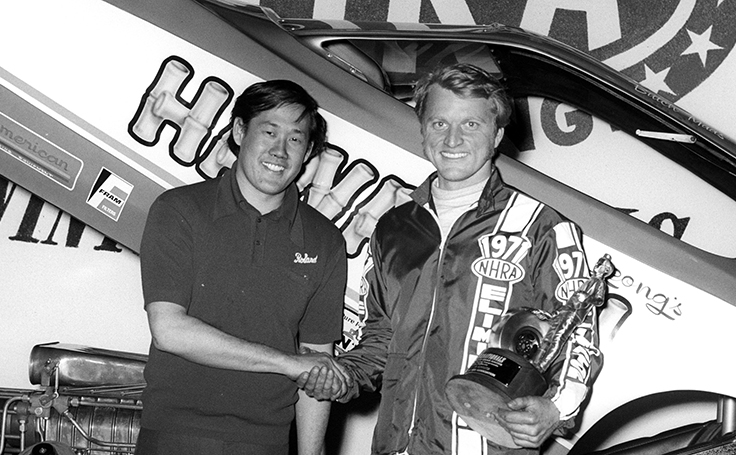
Hello: Butch Maas, a veteran driver of many different rides (27, by his count), had driven Prudhomme’s Top Fueler at the 1970 Supernationals and actually earned his Funny Car license in Prudhomme’s Hot Wheels ’Cuda, and it was his relationship with Prudhomme that led to his short stint in the Hawaiian. Following the footsteps of former Hawaiian drivers Ongais, Prudhomme, Snively, and Reyes, Maas won the Winternationals in his debut in the car in 1971.
Goodbye: Maas received second-degree burns in a match race fire in Cincinnati in late spring and headed home to recover while Leong began work on a new car. Maas says he was surprised a few weeks later to get a call from car owner Ed Wills asking if he’d like to drive the Mr. Ed car because his driver, Bobby Rowe, had just been hired by Leong to drive the Hawaiian.
BOBBY ROWE
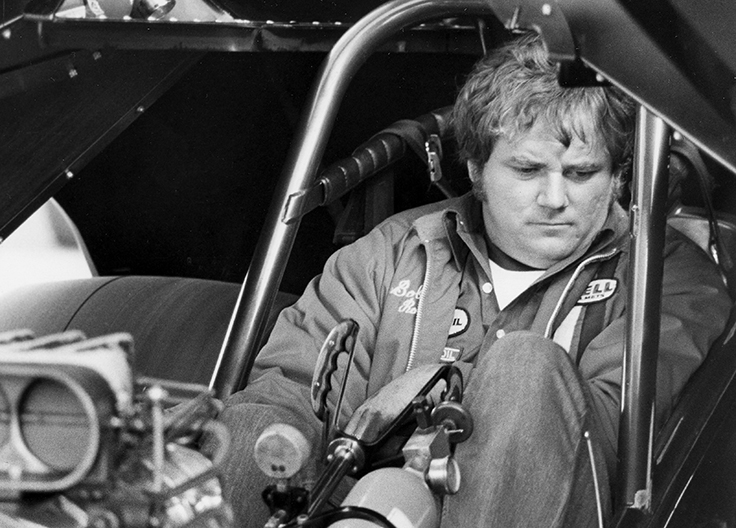
Hello: Bobby Rowe was friends with Reyes and had worked on the original 1969 car during East Coast tours and took over after Maas’ fire.
Goodbye: Rowe left after the 1971 season for unknown reasons and went on to drive for Don Schumacher and Ed Wills.
LEROY CHADDERTON
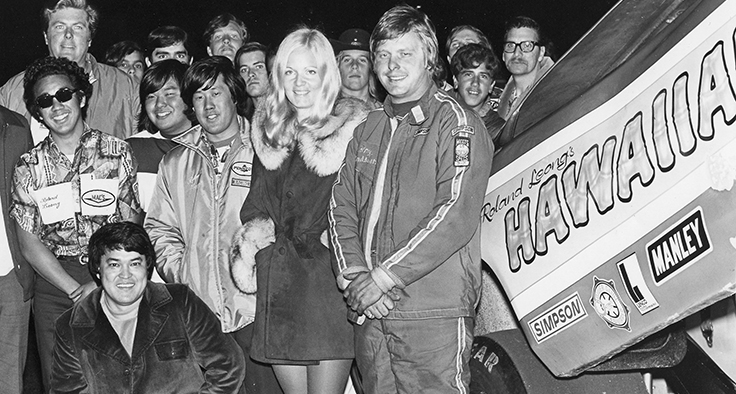
Hello: The late Leroy Chadderton began his stint with Leong in 1972 and drove the first of many Hawaiian cars sponsored by model maker Revell, a beautiful John Buttera-built Dodge Charger.
Goodbye: After the car was stolen from the parking lot of a Holiday Inn in Gary, Ind., in June 1973, Leong returned home to put together a new car, but Chadderton decided he did not want to continue.
GORDIE BONIN
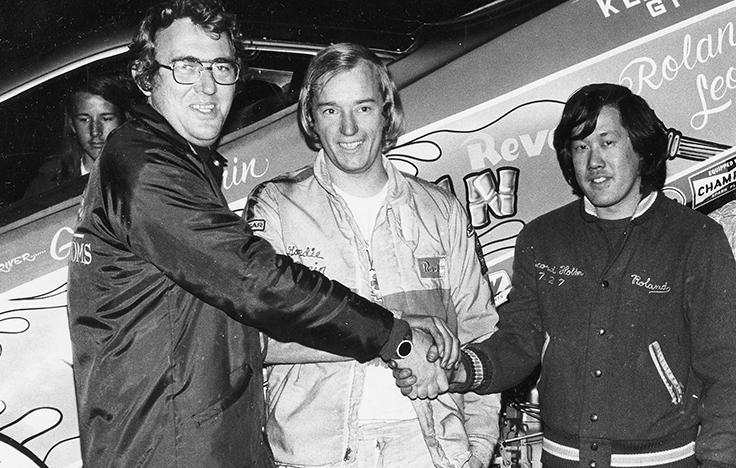
Hello: Gordie Bonin, who had just left the Hodgson & Jenner Pacemaker team, began the first of two stints with Leong, replacing Chadderton in a similar car, a Buttera-built Charger formerly campaigned by Ray Alley and Kenny Bernstein. Bonin was runner-up in his first match race in the car, then followed with a less spectacular outing in Detroit, where he “got crossed up, put it in the weeds on the sidelines, totaled the body, and spent the night in a Detroit emergency [room], but Ro still wanted me to finish the season.”
Goodbye: Remembered Bonin, “At the beginning of the ’74 season, I started talking with [Ron] Hodgson about running the Pacemaker car again. Roland totally understood and even let me stay at his house until I had the Pacemaker operation freshened up and headed north with it.”
MIKE VAN SANT
Hello: Mike Van Sant, who had driven a variety of cars on the West Coast, including his Invader entries, took over for Bonin and drove the car for much of 1974, mostly at match races.
Goodbye: Disagreements over various things.
DENNY SAVAGE
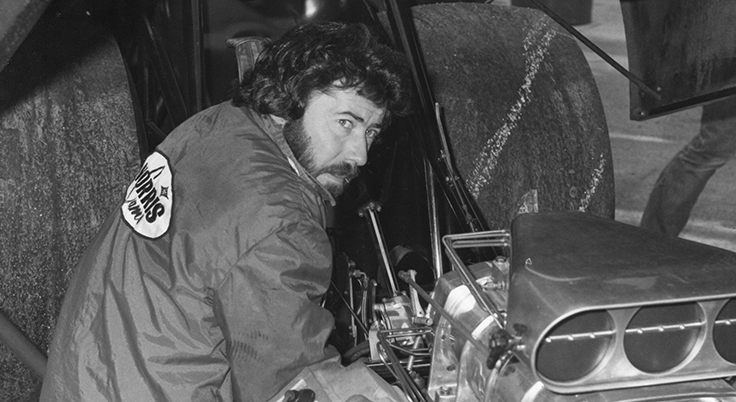
Hello: Denny Savage met Leong at Romeo Palimedes’ shop in Chicago, where Savage’s current ride, Dick Bourgeois’ Doug’s Headers Vega, was based. Recalls Savage, “I was finishing a crank replacement in the Vega (with the engine still in the car); he was amazed by that. After lunch that day, he came back and found me mounting a new set of slicks by hand (not an easy chore) and commented, ‘You do everything, huh?’ Roland was having a hard time with Mike Van Sant at the time; he wouldn’t work on the car. Before Roland left that day, he asked me, ‘You want to work for me?’ I was kinda starstruck, and I said, ‘Sure,’ and I left with him that Saturday to go to Martin, Mich., for a big match race.
"On the first run that night, the car went into a big wheelstand and broke all the framerails in front of the motor. Roland was very upset because he was supposed to run the next day in Rockford, Ill. I called Romeo, and he said he’d meet us there at about midnight. We loaded up, went back to Chicago, worked all night, basically fronthalved the car. Somewhere in the middle of all that while Mike was sleeping in Romeo’s office, Roland told me, ‘If we get this fixed and make it to Rockford tomorrow, you drive my car.’ We made it, and I drove at Rockford. The next day on the way back to Chicago, Roland dropped Mike off at O’Hare [Int’l Airport], and he went home.”
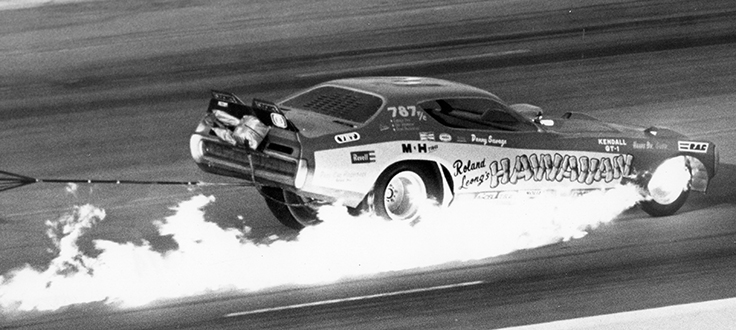
Goodbye: Savage finished out the year in a blaze of glory at the Supernationals in Ontario, Calif., with a huge top-end fireball. Recalls Savage, “A week or so later, after I recovered, I went to Roland’s house to work on the car. Norm Wilcox was there, and Roland told me, ‘This is my new driver.’ I was crushed. Later, I heard that Roland thought that the fire scared me and I didn’t want to drive anymore. Back then, I wasn’t scared of anything. About a month later, Austin Coil called me to drive the Chi-Town Hustler.”
NORM WILCOX
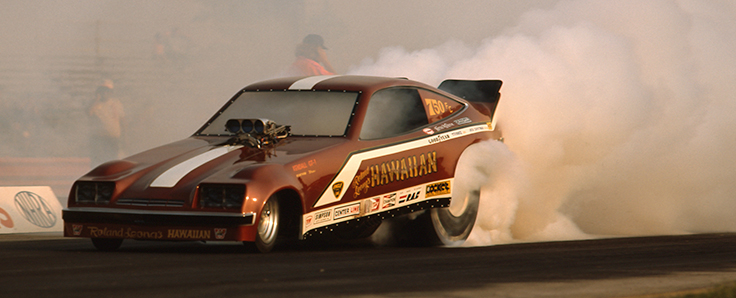
Hello: Took over for Savage at the start of the 1975 season and drove the new Monza-bodied Hawaiian for the next year and a half.
Goodbye: Left for unknown reasons.
LARRY ARNOLD
Hello: Larry Arnold came to work for Leong in 1976 after driving Mickey Thompson’s Grand Am the previous season and years of success in the Kingfish and King Cuda cars.
Goodbye: Left and started a crankshaft company, L.A. Enterprises, in Southern California.
RON COLSON
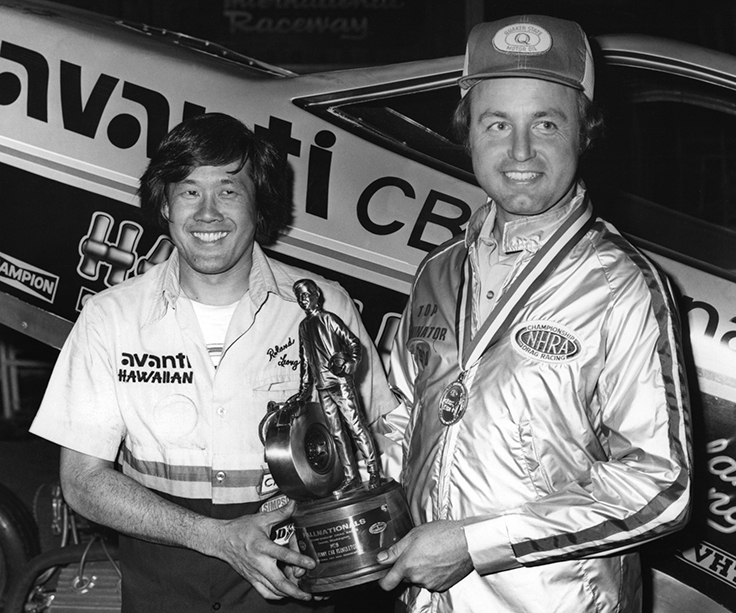
Hello: Ron Colson, who had previously driven the Chi-Town Hustler and other rides, enjoyed the longest tenure of any Hawaiian driver, from mid-1976 through the end of the 1980 season. Together they won the 1978 Fallnationals and 1980 World Finals and wheeled a variety of cars — a Monza, Corvette, and Omni — for many of Leong’s sponsors through those years, including Powergloss, Avanti Antennas, and King’s Hawaiian Bread. They finished fifth in points in 1979 and third in 1980.

Goodbye: After more than 20 years of driving, 15 of which were in nitro cars, Colson retired from driving to open a racing-consultant business.
MIKE DUNN

Hello: Mike Dunn had worked as a crewmember on the Hawaiian since the summer of 1977, the same year he had earned his nitro license in his dad’s car. “He told me at the time I was his backup driver in case Colson couldn’t make it, but I realized that probably wasn’t going to happen,” said Dunn, who, on Leong’s advice and with Leong’s help, drove for Bill Schifsky in 1980.
“I was running a match for Bill in Sioux Falls, S.D., right after Indy when Roland called. I took a Greyhound bus to Des Moines [Iowa] because you couldn’t get an airplane out of there, and he picked me up, and I went back home with them. At that point, I was on the list of drivers but not at the top of the list, but I won the first race I ran for him later that year. It did a wheelstand, and I shifted high gear to come out of it and win the race, and that got me the job.” Colson and Dunn actually shared the car in late 1980, when Dunn ran several match races in the car. Dunn won the Golden Gate Nationals his first year in the car and was runner-up at the 1982 Summernationals.
Goodbye: The 1983 season was marked by crashes in Columbus, Ohio, and Orange County in California with the new Hawaiian Punch Dodge, and Dunn’s 1984 season — and his ride in the car — ended in the summer when the car broke the rear end during a match race in Kansas City, Mo. The coupler shattered and pierced his left leg and broke the bone. “I would have kept driving,” he said, “but because it also lacerated my leg, I had to keep it elevated or the leg would swell up in the cast. Plus, by that time I was beginning to think my luck just wasn’t there with the car.”
JIM DUNN
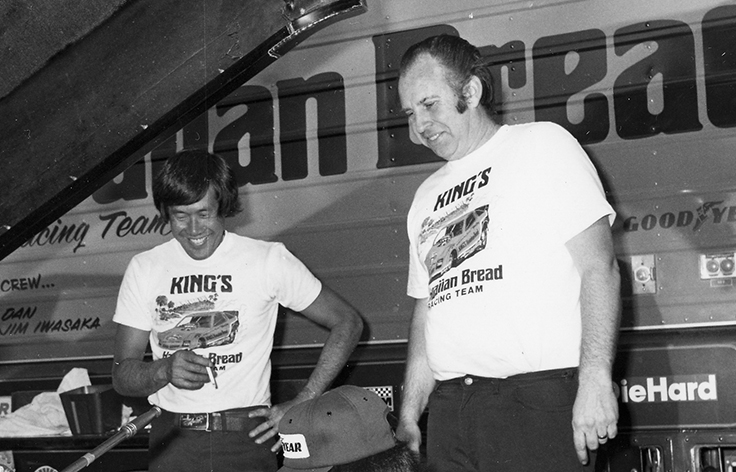
Hello: Newly hired Mike Dunn was still in Australia when the 1981 season began with the Coors Super Bowl of Drag Racing at Orange County Int’l Raceway, so his dad took the seat of the King’s Hawaiian Bread Dodge and powered the car to a stunning and controversial 5.85, seven-hundredths quicker than the class’ best time.
Goodbye: “Big Jim” went back to his own car when his son returned from Down Under.
RICK JOHNSON

Hello: Mike Dunn actually recommended Rick Johnson as his replacement, and although Dunn had expressed an interest in returning, Leong decided to stick with Johnson for the balance of 1984 and all of 1985. They had considerable success together, including winning the 1985 Le Grandnational and finished a Leong-career-high second in points that year behind only Bernstein.
Goodbye: Johnson was let go at the end of the 1985 season after various disagreements.
JOHNNY WEST

Hello: Johnny West, who had been running his Plan A Funny Car and was weighing his future in the sport, was recommended to Leong by Tom McEwen and took over during the 1985 Winter Series. They raced together for three seasons and reached two final rounds but never won. They finished fifth in 1986 and eighth in 1987 and 1988.
Goodbye: West and Leong parted company amicably at the end of 1988, and West returned to running his car after signing a sponsorship deal with Motorola.
JIM WHITE

Hello: The Tulsa, Okla.-based driver, who Leong met through longtime friend and Tulsa nitro legend Bob Creitz, easily was Leong’s most successful driver. Between 1989 and 1991, Jim White won four national events and scored three runner-ups. They finished fifth in 1990 and second in 1991, when the team swept all honors in Indy with a win in Sunday’s Big Bud Shootout followed by a first U.S. Nationals win for both of them.
Goodbye: Recalls Leong, “We knew that 1991 was the last year for the Hawaiian Punch sponsorship because the company was sold. I gave Jim his checks at the last race of 1991 and never heard from him again until two or three years ago when he drove up to my house. This is 15 years later, right? He told me he knew it was his fault the way it ended and that he messed up. He thanked me for everything that I had done for his career, which was nice.”
GORDIE BONIN
Hello: After sitting out 1992, Leong signed a three-year deal with the Hawaiian tourism board beginning in 1993 and hired old pal Gordie Bonin back into the seat. “We had always stayed in touch; I even helped him book some match races in Canada,” recalls Bonin. “In late 1992, he told me he was working on a deal from Hawaii, and if he got it, he wanted me to drive and market the team. I’ll never forget the phone call at 6:30 a.m. I was in Penticton, B.C., in the dead of winter, working for an extended car warranty company. He says, ‘Boy, we got jobs!’ I told my boss I was going to Pomona for the Winternationals and left. I sent my resignation letter back on Monday after the race and stayed down there to build a hot rod for the 1993 season. A young Larry Dixon was loaned to us by ‘the Snake,’ and Leonard Hughes, Ro, and I got her done. It was a hell of a season, ’til the state of Hawaii pulled the plug on the deal.”

Goodbye: “The bottom line is that one of the politicians lied to me,” said Leong. “He gave us just enough money to get in trouble, so to speak, and told me he’d get us the money for the rest of the year later, and it turned out he never had any intentions of doing that. That was the end of my time as a car owner.”
So, there you have it, a complete list of Leong's NHRA big-show drivers as a team owner spanning more than 20 years of winning at national events and match races. He went on to a second wonderful career as the go-to tuner for Nostalgia Funny Cars, although he wasn't the owner of any of those cars. He was one of a kind, with an eye for talent but also a tight hand on the tiller, both of which made him one of the most revered and successful car owners of all time.
There will be a celebration of Leong's life, that is open to the public, on March 21 (Thursday of the Winternationals) at 5 p.m. Pacific at the Lions Museum, 2790 E Del Amo Blvd, Rancho Dominguez, CA 90221. I'll be there. I hope to see some of you there, too.
Phil Burgess can be reached at pburgess@nhra.com
Hundreds of more articles like this can be found in the DRAGSTER INSIDER COLUMN ARCHIVE
Or try the Random Dragster Insider story generator




















































